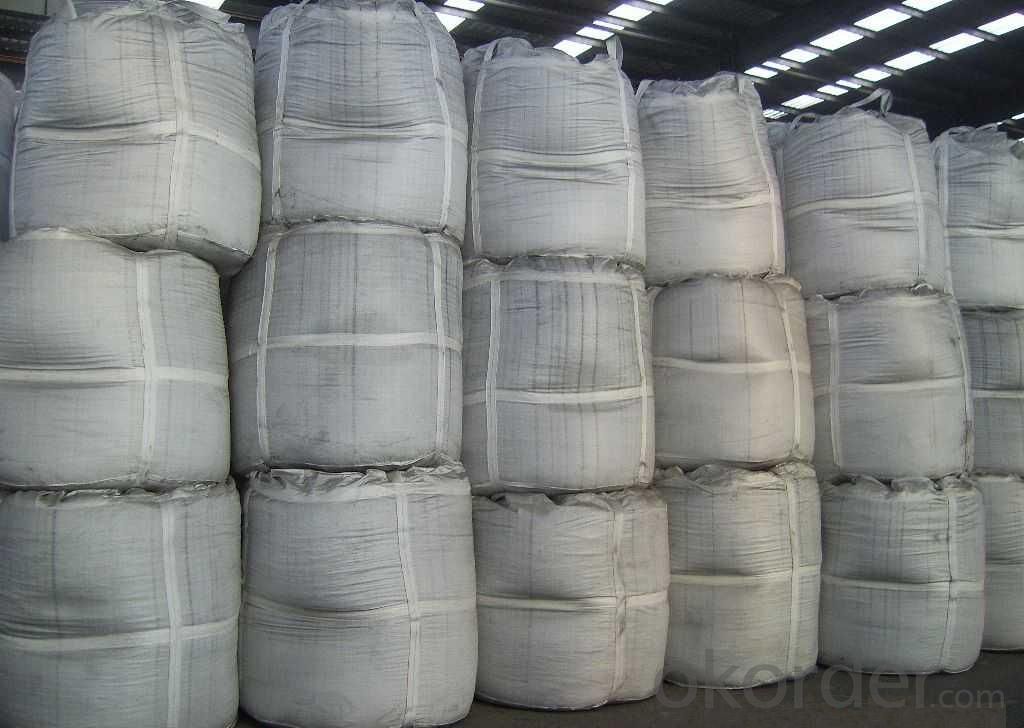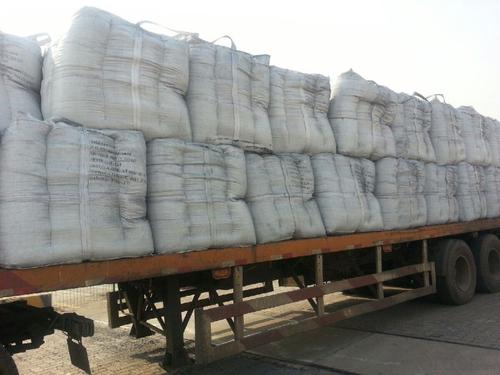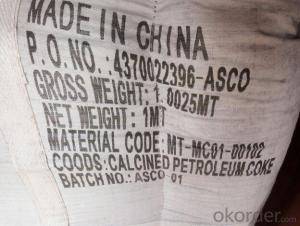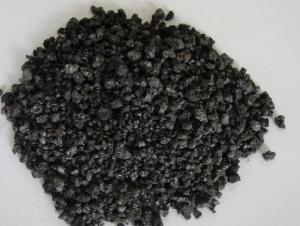Calcined Peroleum Coke with FC 98.5% S 0.55%max
- Loading Port:
- Tianjin
- Payment Terms:
- TT OR LC
- Min Order Qty:
- 20 m.t.
- Supply Capability:
- 2000 m.t./month
OKorder Service Pledge
OKorder Financial Service
You Might Also Like
Packaging & Delivery
25kgs/50kgs/1ton per bag or as buyer's request
Calcined Petroleum Coke is a critical ingredient in the production of Metallurgy and chemical industrial ,it can increase the used quantity of Scrap steel and reduce the quantity of Scrap iron, or use no Scrap iron at all, the calcined petroleum coke has follow properties: high absorptive character, no residue will be left and save production cost.
User : Calcined Petroleum Coke comes from delayed coke which extracted from oil refinery. Although Calcined Petroleum Coke contains a little bit higher level of sulfur and nitrogen than pitch coke, the price advantage still makes it widely used during steel-making and founding as a kind of carbon additive/carburant.
Standard Sizes (Granulometry):
0-4 mm, 0.5-3 mm, 0-25 mm, 1-4 mm, 2-8 mm We also supply as per customer's requirement.
General Specification of Calcined Anthracite:
| FC % | 98.5 | 98.5 | 98.5 | 99 |
| ASH % | 0.8 | 0.8 | 0.8 | 0.5 |
| V.M. % | 0.7 | 0.7 | 0.7 | 0.5 |
| S % | 0.5 | 0.55 | 0.7 | 0.5 |
| MOISTURE % | 0.5 | 0.5 | 0.5 | 0.5 |
Picture of CPC/ Calcined Petroleum Coke

- Q: What are the effects of carbon emissions on the stability of ice shelves?
- Carbon emissions have significant effects on the stability of ice shelves. As carbon dioxide (CO2) and other greenhouse gases are released into the atmosphere, they trap heat and contribute to global warming. This increased global temperature leads to the melting of ice shelves and glaciers. One of the primary effects of carbon emissions on ice shelves is the acceleration of their melting rates. Higher atmospheric temperatures cause more ice to melt, which in turn increases the amount of water flowing into the ocean. This added influx of freshwater can disrupt the delicate balance between the ice shelf and the ocean, potentially leading to ice shelf collapse. Additionally, carbon emissions contribute to the thinning of ice shelves. As the atmosphere warms, the air temperature above the ice shelves rises, leading to increased surface melting. This meltwater then flows into crevasses and cracks, causing further fracturing and weakening of the ice shelves. Over time, this thinning can make the ice shelves more susceptible to breaking apart. The melting of ice shelves due to carbon emissions also has indirect effects on the stability of surrounding ice sheets. Ice shelves act as a buttress, providing resistance to the flow of ice from the glaciers into the ocean. When ice shelves collapse or thin, this resistance is diminished, allowing glaciers to flow more freely into the ocean. This process leads to increased sea level rise, which has significant implications for coastal regions around the world. Furthermore, the loss of ice shelves can disrupt the ecosystem and biodiversity of the surrounding areas. Ice shelves provide a platform for various species, including seals and penguins, to breed and feed. When ice shelves disintegrate, these habitats are destroyed, impacting the entire food chain and ecosystem dynamics. Overall, carbon emissions from human activities have profound effects on the stability of ice shelves. The melting, thinning, and collapse of ice shelves contribute to rising sea levels, disrupt ecosystems, and have far-reaching consequences for coastal communities. It is crucial to mitigate carbon emissions and take proactive measures to protect these vulnerable ice shelves and the delicate balance they maintain in our global climate system.
- Q: How does carbon dioxide affect global warming?
- Global warming is caused by carbon dioxide, one of the main greenhouse gases. When carbon dioxide is released into the atmosphere, it traps heat from the sun and prevents it from escaping into space. This leads to a rise in the Earth's overall temperature, a phenomenon known as the greenhouse effect. The Earth's atmosphere acts like the walls of a greenhouse, trapping heat and warming the planet. Human activities, such as burning fossil fuels, deforestation, and industrial processes, have significantly increased the amount of carbon dioxide in the atmosphere. These activities have released large amounts of carbon dioxide that would have otherwise remained underground for millions of years. As a result, the concentration of carbon dioxide in the atmosphere has reached levels not seen in hundreds of thousands of years. The increase in carbon dioxide levels intensifies the greenhouse effect and worsens global warming. Rising temperatures have negative effects on the Earth's climate system, including the melting of polar ice caps and glaciers, which leads to rising sea levels. This poses a threat to coastal communities and low-lying areas, increasing the risk of flooding and erosion. Additionally, global warming disrupts weather patterns, resulting in more frequent and severe extreme weather events like hurricanes, droughts, and heatwaves. Moreover, global warming impacts ecosystems and biodiversity. Many species are unable to adapt to rapid temperature changes, resulting in habitat loss and an increased risk of extinction. Coral reefs, for instance, are highly sensitive to temperature changes and are experiencing widespread bleaching events due to warmer ocean temperatures. Efforts are being made to reduce greenhouse gas emissions and mitigate the effects of carbon dioxide on global warming. Measures such as transitioning to renewable energy sources, improving energy efficiency, reforesting, and implementing sustainable practices are being taken to curb carbon dioxide emissions and lessen the impacts of global warming.
- Q: What is the role of carbon in the formation of diamonds?
- The role of carbon in the formation of diamonds is essential, as diamonds are composed entirely of carbon atoms arranged in a crystal lattice structure. The extreme heat and pressure deep within the Earth's mantle cause carbon atoms to bond tightly together, forming the unique structure of a diamond. Without carbon, diamonds would not exist.
- Q: What is diamond?
- Diamond is a naturally occurring precious gemstone that is composed of carbon atoms arranged in a unique crystal lattice structure, known for its exceptional hardness, brilliance, and durability.
- Q: What are carbon nanotubes?
- Carbon nanotubes are cylindrical structures made entirely of carbon atoms arranged in a unique way. They have a diameter of only a few nanometers, hence the name "nanotubes". These tubes can be incredibly long, with lengths that can reach up to several centimeters. Carbon nanotubes possess extraordinary properties due to their unique structure. They are incredibly strong and have excellent mechanical properties, being about 100 times stronger than steel at one-sixth of the weight. Additionally, they have exceptional thermal and electrical conductivity. These nanotubes can be categorized into two main types: single-walled carbon nanotubes (SWCNTs) and multi-walled carbon nanotubes (MWCNTs). The single-walled nanotubes consist of a single layer of carbon atoms rolled into a tube, while multi-walled nanotubes consist of multiple layers of these tubes nested within each other. Carbon nanotubes find applications in various fields due to their exceptional properties. In electronics, they are used as transistors and interconnects due to their high electrical conductivity. They are also utilized in energy storage devices, such as batteries and supercapacitors, due to their high surface area and high electrical conductivity. In materials science, carbon nanotubes are used to reinforce composites, making them stronger and lighter. They also have potential applications in medicine, as drug delivery systems and as imaging agents. Research is ongoing to further understand and harness the potential of carbon nanotubes. However, challenges remain in terms of their large-scale production, cost-effectiveness, and potential health and environmental concerns. Overall, carbon nanotubes represent an exciting and promising area of nanotechnology with vast potential for advancements in various fields.
- Q: How does carbon dioxide contribute to ocean acidification?
- Ocean acidification is caused by the presence of carbon dioxide, which forms carbonic acid when it dissolves in seawater. This reaction results in an increase in hydrogen ions and a decrease in pH, making the water more acidic. Human activities, especially the burning of fossil fuels, are leading to a rise in carbon dioxide emissions. As a result, more carbon dioxide is being absorbed by the oceans, disrupting the natural balance between atmospheric and oceanic carbon dioxide levels. This excess absorption leads to an accumulation of carbon dioxide in the seawater. The increased acidity of the seawater poses a significant threat to marine life. Many organisms, such as corals, shellfish, and certain types of plankton, rely on calcium carbonate to construct their shells or skeletons. However, in more acidic water, the availability of carbonate ions, necessary for calcium carbonate formation, decreases. Consequently, these organisms struggle to build and maintain their protective structures, rendering them more susceptible to predation and other dangers. Ocean acidification also has adverse effects on the growth, development, and behavior of numerous other marine species. For example, it can disrupt fish reproductive cycles and alter the behavior of certain species, making them more vulnerable to predators or adversely affecting their ability to locate food or mates. Moreover, ocean acidification can trigger a chain reaction that impacts entire marine ecosystems. The interconnectedness of species in complex food webs means that any disturbance to one species can have far-reaching consequences for others. If the population of a particular fish species declines due to acidification, it can have a ripple effect on the entire food chain, influencing the abundance and distribution of other species. In conclusion, the process of ocean acidification occurs as carbon dioxide dissolves in seawater and forms carbonic acid, resulting in an increase in hydrogen ions and a decrease in pH. This process has detrimental effects on marine organisms, particularly those reliant on calcium carbonate for their shells or skeletons. It also disrupts the growth, development, and behavior of various marine species and can have cascading impacts on entire ecosystems.
- Q: How do you use carbon fourteen to measure the age?
- Then, carbon - 14 dating method is to determine the remains of ancient age? Originally, cosmic rays can produce radioactive carbon -- 14 in the atmosphere, and can enter all living tissue carbon dioxide and oxygen - synthesis combined, first for the absorption of plants, after the animal into a plant or animal. As long as they live. Continuous absorption of carbon - 14, to maintain a certain level in the body. When the organism dies, which will stop breathing carbon - 14, within their organization, with a half-life of 14 carbon began 5730 years of decay and gradually disappear. For any carbon containing material, as long as the determination of the remaining 14 of the content of radioactive carbon you can, that the age of 14. Carbon dating method is divided into conventional carbon - 14 dating method and carbon - 14 accelerator mass spectrometry dating two. At that time, since it is invented by Libby conventional carbon - 14 dating method, this 1950. The technology and application of methods have significant progress in the world, but its limitations are obvious, namely the time measurement must use a large number of samples and longer. Thus, carbon - 14 dating accelerator mass spectrometry technology developed. Carbon - 14 accelerator mass spectrometry dating method has unique advantages.
- Q: Who is the high carbon content of stainless steel and ordinary steel?
- Two, stainless steel according to different varieties, including carbon: 0--0.15%,Of which: 0--0.03% is called low carbon stainless steel.So, generally speaking, carbon steel has a higher carbon content.
- Q: Who can explain that bare feet on fire carbon don't burn feet?
- First coated with Yunnan Baiyao to run, injury probability can be greatly reduced, we have such a custom inside the village, and then those children have to paint up and run, generally nothing
- Q: What is carbon neutral packaging?
- Carbon neutral packaging refers to packaging materials and processes that have a net zero carbon footprint. This means that the amount of carbon dioxide (CO2) emissions released during the production, transportation, and disposal of the packaging is offset by an equal amount of CO2 being removed from the atmosphere or not being emitted in the first place. To achieve carbon neutrality, various strategies can be employed. One common approach is to use renewable or recycled materials for packaging, such as paper or bioplastics made from plant-based sources. These materials have a lower carbon footprint compared to traditional petroleum-based plastics. Additionally, reducing the overall amount of packaging used and optimizing the design to minimize waste can also contribute to carbon neutrality. Another important aspect of carbon neutral packaging is the offsetting of unavoidable emissions. This can be done through investing in projects that reduce greenhouse gas emissions elsewhere, such as reforestation or renewable energy initiatives. By supporting these projects, the carbon emissions generated by the packaging are balanced out, resulting in a net zero impact on the environment. The concept of carbon neutral packaging is gaining popularity as businesses and consumers become more aware of the environmental impact of their choices. It provides a way to reduce the carbon footprint associated with packaging, ultimately contributing to a more sustainable and eco-friendly future.
Send your message to us
Calcined Peroleum Coke with FC 98.5% S 0.55%max
- Loading Port:
- Tianjin
- Payment Terms:
- TT OR LC
- Min Order Qty:
- 20 m.t.
- Supply Capability:
- 2000 m.t./month
OKorder Service Pledge
OKorder Financial Service
Similar products
Hot products
Hot Searches























